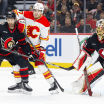Success on special teams is your meal ticket. It was once thought that if your powerplay and penalty-kill added up to a 100% or more, you were in a good spot and likely one of the league's true competitors.
(For reference, the Flames currently sit at 101.6%, with their seventh-ranked, 81.9% PK doing the bulk of the heavy lifting in this way.)
Sutter, though, has a different view on it.
The Flames have been shorthanded 149 times this year - the sixth-most, league-wide - and have allowed 27 powerplay tallies, putting them right in the middle of the pack in that category. You don't have to be a math major to see that if you spend less time in the box, you'll give up fewer goals.
And win more games.
The opposite is true when it comes to the powerplay. Draw more - score more.
Still, the players can't help but feel invigorated after getting a few to drop the other night in Chicago after going a long stretch without much to celebrate.
"It was good to see," said Tyler Toffoli, who was instrumental on both PPGs against the Blackhawks, providing a simple, direct shooting threat that had been absent in prior games. "Obviously, we've been talking about it a bunch and were trying to figure out way through things and execute better, and I think that was a good start for us.
"Obviously, getting shots through is key. Getting more volume on net and getting the penalty-killers moving around is huge, too. Lindy (Elias Lindholm)'s goal was exactly that, and something we've been talking about for the past little bit here. We were moving it around, being crisp, shooting and - most importantly - getting the puck through."
The Flames were remarkably efficient in that game, scoring twice on only three opportunities and using only 1:22 of powerplay time to bury the two pucks.
That, too, is a point of emphasis for the Flames moving forward: Catching the killers off guard and opening up seams with a dynamic presence off the draw.
It's what led to the Nazem Kadri marker, who swept home a Lindholm pass from the bumper position after Toffoli - stationed up top in the left point - sent a feed down to No. 28 at the goal line.
The quick puck movement opened up seams that maybe hadn't existed, previously.
"If you look at the majority of the good powerplays in the league, that's what they're known for," Toffoli said. "They're quick. They're crisp. They execute because if you're out there getting the penalty-killers to run around a bit, it opens up space for everyone.
"And then, obviously, you have to capitalize."

















